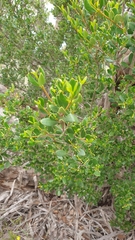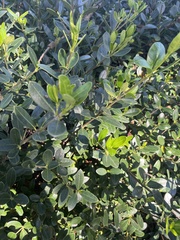Alyxia buxifolia: taxon details and analytics
- Domain
- Kingdom
- Plantae
- Phylum
- Tracheophyta
- Class
- Magnoliopsida
- Order
- Gentianales
- Family
- Apocynaceae
- Genus
- Alyxia
- Species
- Alyxia buxifolia
- Scientific Name
- Alyxia buxifolia
Summary description from Wikipedia:
Alyxia buxifolia
Alyxia buxifolia, otherwise known as the sea box or dysentery bush, is a species of evergreen shrub in the family Apocynaceae.
Alyxia buxifolia has medium to dark green foliage consisting of small, fleshy leaves. The flowers are small and twisted anticlockwise in a star shape. They are orange at the base of the petal and are a white-cream colour at the tip of the petal. It flowers in spring through to autumn. Alyxia buxifolia produces small fruits that are red to orange in colour when ripe.
Alyxia buxifolia has several synonyms though the current accepted name is Alyxia buxifolia R. Br.
It is found naturally occurring throughout southern Australia and can be found in Western Australia, South Australia, Victoria, Tasmania, New South Wales. Alyxia buxifolia occurs in coastal regions, often being found in scrub and heathland ecosystems. It can grow in many types of soils and is considered a hardy plant due to being tolerant of wind, salt, and some frost conditions. Alyxia buxifolia also creates habitat for small animals and provides food for birds and invertebrates.
The shrub also contains several compounds of interest which include oleanolic acids, ursolic acids, and betulinic acid.
It is used in many horticultural and landscape settings. It was also used by First Nations people of Australia to treat dysentery.
Alyxia buxifolia is currently considered not to be under threat.
...Alyxia buxifolia in languages:
- English
- Sea Box
Images from inaturalist.org observations:
We recommend you sign up for this excellent, free service.
Parent Taxon
Sibling Taxa
- Alyxia acuminata
- Alyxia angustifolia
- Alyxia bracteolosa
- Alyxia buxifolia
- Alyxia cacuminum
- Alyxia composita
- Alyxia concatenata
- Alyxia defoliata
- Alyxia erythrosperma
- Alyxia floribunda
- Alyxia ganophylla
- Alyxia graciliflora
- Alyxia grandis
- Alyxia gynopogon
- Alyxia halmaheirae
- Alyxia ilicifolia
- Alyxia kaalaensis
- Alyxia kendarica
- Alyxia kwalotabaa
- Alyxia lamii
- Alyxia laurina
- Alyxia leucogyne
- Alyxia loeseneriana
- Alyxia longiloba
- Alyxia luzoniensis
- Alyxia magnifolia
- Alyxia manusiana
- Alyxia markgrafii
- Alyxia menglungensis
- Alyxia microphylla
- Alyxia monticola
- Alyxia mujongensis
- Alyxia multistriata
- Alyxia oblongata
- Alyxia oleifolia
- Alyxia orophila
- Alyxia palawanensis
- Alyxia papuana
- Alyxia pilosa
- Alyxia poyaensis
- Alyxia pugio
- Alyxia pullei
- Alyxia punctata
- Alyxia reinwardtii
- Alyxia ridleyana
- Alyxia rostrata
- Alyxia royeniana
- Alyxia ruscifolia
- Alyxia sarasinii
- Alyxia scabrida
- Alyxia schlechteri
- Alyxia semipallescens
- Alyxia sharpei
- Alyxia sinensis
- Alyxia sleumeri
- Alyxia sogerensis
- Alyxia solomonensis
- Alyxia spicata
- Alyxia squamulosa
- Alyxia stellata
- Alyxia sulana
- Alyxia taiwanensis
- Alyxia tetraquetra
- Alyxia tisserantii
- Alyxia tropica
- Alyxia veillonii































































































































































